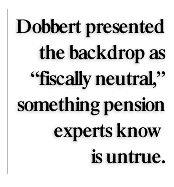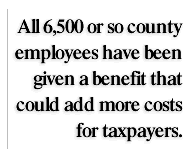Dobbert’s Folly: How His Errors Will Cost Taxpayers More
It was sometime in the winter of 1999/2000 that Gary Dobbert went to a conference on the West Coast where he learned about pension plans with a lump sum pay out. Dobbert, then Ament’s head of human resources, clearly didn’t learn enough, and he made some serious, nationally unprecedented mistakes in Milwaukee County’s plan. These errors, and their likely fiscal impact, have yet to be discussed. But they are certain to cause more pain for county officials and taxpayers.
 To fully appreciate Dobbert’s folly, you need some background about so-called DROPs or Deferred Retirement Option Plans, from which the county’s backdrop plan was derived. I trudged through some truly boring publications, like the Journal of Pension Benefits and the Journal of Deferred Compensation, in order to give you, dear readers, a simple explanation.
To fully appreciate Dobbert’s folly, you need some background about so-called DROPs or Deferred Retirement Option Plans, from which the county’s backdrop plan was derived. I trudged through some truly boring publications, like the Journal of Pension Benefits and the Journal of Deferred Compensation, in order to give you, dear readers, a simple explanation.
The first DROP plan was created in 1982 by the local government in Baton Rouge, Louisiana. Given the shady history of Louisiana government officials, that is not the most auspicious authorship, but the idea caught on nonetheless. Today, four state systems have DROP plans. There are 37 local plans in Texas alone. About 10 percent of government employees in America can opt for some form of a DROP plan.
DROPs are used to encourage valuable employees who may have maxed out on their pension benefits to stay longer. Many governments, including Milwaukee County, barred any employee from getting more than 80% of their final average salary on their pension. Once an employee hit that level, there was little financial reason to continue on the job.
Governments offering these plans, however, have proceeded carefully, given how quickly compounded interest can accumulate. Typically, there is a limit to the number of years a DROP can pile up money for an employee, usually two to five years. Dobbert, by contrast, created a plan that goes on forever, which allowed Ament to collect compound interest for an incredible 13 years, had he served (as planned) until 2008.
Most plans also put a cap on the rate of interest paid. “DROP assets generally earn between 4% and 7% a year in interest,” notes that fascinating publication, Plan Sponsor Magazine. Dobbert, instead, drew up a plan offering 8.5% interest.
The magazine notes that the Oklahoma firefighters plan is considered “particularly generous,” and has a maximum length of five years and offers an interest rate 2 percent lower than the pension fund’s average earnings. Milwaukee’s plan is much more generous than that.
DROP plans work forwards; that is, employees choose this option well before retiring and the government starts putting aside money for their eventual lump sum payment. Dobbert chose a variant of this, called backdrop, which allows employees to choose the lump sum upon quitting, which is calculated backwards to the original date they were eligible for retirement. While backdrop works on the same principle as a DROP, it is based on a little known theory for which there is scant practical experience. “I haven’t seen or heard of any examples of backdrop being used anywhere in the United States,” says Jac Amerell, secretary to the Milwaukee County Pension Board.
 But Dobbert’s most monumental error was to include a 25% increase in veteran employees’ pension benefits and then add backdrop on top of this, meaning the county would multiply 8.5% times 25% as it totaled the lump sums. I could find no examples in the literature of a government that ever considered such a calculation.
But Dobbert’s most monumental error was to include a 25% increase in veteran employees’ pension benefits and then add backdrop on top of this, meaning the county would multiply 8.5% times 25% as it totaled the lump sums. I could find no examples in the literature of a government that ever considered such a calculation.
Indeed, Dobbert’s plan completely contradicts the logic of DROP plans, which were expressly created for workers who had maxed out their pensions. Under Dobbert’s plan, Milwaukee County’s veteran employees hadn’t maxed out, but were eligible to increase their benefits by 25% if they continued to work until April, 2004.
It was rather unprecedented for any government to give the 25% increase, which allows employees to, in essence, go from 80% to 105% of their salary in computing their pension benefits. But Dobbert blew away any possible precedent by adding a backdrop paying such a high interest rate for so long a period of time.
Then Dobbert presented the backdrop as “fiscally neutral,” something pension experts know is untrue. “Although often touted as cost-neutral, DROPs commonly add to 2% to 3% of payroll to plan costs,” writes Charles Chittenden, Phoenix-based consulting actuary. Plan Sponsor magazine notes that if fiscal neutrality is the goal, the interest paid has to be less than that earned by the government’s pension fund.
In retrospect, it seems incredible that Ament, County Board Chair Karen Ordinans and others took Dobbert’s word for it that the backdrop plan would be fiscally neutral. Nor did either of them ask William M. Mercer, the company that advises the county on its pension benefits, to do an independent analysis of the backdrop.
Here’s the final irony: Milwaukee happens to be the home of the International Foundation of Employee Benefit Plans, national experts in matters like DROPs. As a non-profit, they offer free advice to any government official that calls. Indeed, they sent me a raft of deadly dull but very informative articles on this subject. In the past, union representatives have consulted this organization for background material. So why didn’t Ordinans, who spent years as a union negotiator, call this organization for information?
If the county truly wanted to retain long-term employees, experience elsewhere shows that it didn’t need to offer the 25% bonus and could have simply offered a backdrop with a mere 3-5% interest rate, which has proven to retain employees while adding no costs for governments.
Or had the county given the preposterous 25% bonus but at least limited the backdrop interest rate to, say, 5 or even 6%, it could have continue to grow the pension fund (which has averaged 11% over that last 20 years), and use the investment returns to cover much of the 25% increase for veterans along with the backdrop costs. But Dobbert’s plan rules out this strategy because it pays employees the assumed rate of return for the pension fund.
This leaves the county with no fiscal flexibility. Recently, the county increased the assumed rate of return on the pension fund from 8.5% to 9%. In the past, such an action would allow the county to pay less property taxes to the fund, since its investments are doing so well. But now that every employee’s backdrop payment is tied to that assumed rate of interest, the county automatically increases its pension liability by upping this rate. Going the other way, the county could lower the assumed rate of interest, but that means the fund is growing slower and therefore needs more property tax contributions. In essence, Dobbert’s plan has eliminated the ability of the county to use the pension fund’s investment returns to keep property tax contributions down. And that was the main justification for the pension plan.
But it gets worse still. Dobbert’s plan gave the 25% increase only to veteran employees, but it extended the backdrop to every county employee. As we’ve already learned, the backdrop plan is not fiscally neutral, even without the 25% bonus. In short, all 6,500 or so county employees have been given a benefit that could add more costs for taxpayers should these employees work beyond the date they are first eligible for retirement.
The county needs to pass an ordinance that eliminates the backdrop or caps the interest rate and years of eligibility for any future employees. The county may have also lost its flexibility to keep any employees on, no matter how valuable, past the date they are first eligible for retirement.
The board also needs to learn more about the experience of other governments to fully estimate the fiscal nightmare it has created for itself. Recently one expert told the board the backdrop doesn’t pay off for most employees, implying that most wouldn’t choose this option. So far, that hasn’t been the case in Milwaukee, and it doesn’t appear to be the case in other cities. If the county is going to avoid compounding Dobbert’s folly, it had better find smarter advisors than that.
This article was originally published by Milwaukee World.
Murphy's Law
-
Is Legislature Biased Against Working Class?
 Apr 4th, 2024 by Bruce Murphy
Apr 4th, 2024 by Bruce Murphy
-
Associated Press Will Decline in Wisconsin
 Mar 27th, 2024 by Bruce Murphy
Mar 27th, 2024 by Bruce Murphy
-
City Attorney Race Is Vitally Important
 Mar 25th, 2024 by Bruce Murphy
Mar 25th, 2024 by Bruce Murphy
















